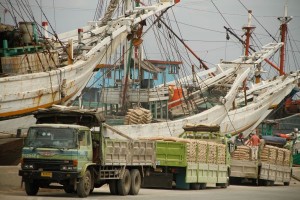 Slowing growth and rising unemployment sometimes induce economies to become more inward-oriented with restrictive policies. Indonesia shows early signs of such tendencies and its future growth may be at risk. The experience of high performing East Asian economies, however, suggests that outward-oriented policies and infrastructure investment support sustainable growth.
Slowing growth and rising unemployment sometimes induce economies to become more inward-oriented with restrictive policies. Indonesia shows early signs of such tendencies and its future growth may be at risk. The experience of high performing East Asian economies, however, suggests that outward-oriented policies and infrastructure investment support sustainable growth.
How Much is Growth Slowing?
Indonesia’s growth slowed to 6.2% in 2012 from 6.5% in 2011. Its growth in the previous decade was below 6%. A slight dip notwithstanding, a turnaround seems to be continuing in this resource-rich economy once seen by the West as a basket case of crony capitalism during the 1997–1998 Asian financial crisis. The modest drop in growth in 2012, reflecting a slowing economy in the fourth quarter, was mainly due to slower disbursement of capital spending compared to previous years and the lingering effects of the global economic slowdown.
Indonesia’s respectable growth over the past ten years can be attributed to four key factors. The first factor was the implementation of major structural reforms during and immediately after the Asian financial crisis. The measures included the liberalization of trade and investment, the dismantling of domestic monopolies, the expansion of the privatization program, financial sector reform, and the establishment of an effective bankruptcy system. The second factor has been the robust demand for resources (e.g., coal, oil, and palm oil)—the mainstay of Indonesia’s economic activity—from rapidly growing India and the People’s Republic of China (PRC). The third factor has been buoyant domestic consumption, which accounts for some 60% of Indonesia’s GDP. The fourth factor has been an expansion in manufacturing, particularly by large foreign companies. Inward investment surged to a record $23 billion in 2012, led by production expansion by Japanese automakers Toyota and Nissan, as well as French cosmetics company L’Oreal.
Signs of a Shift in Policy
Amid the dip in growth, there are concerns that Indonesia is adopting more restrictive policies and risks backsliding on past, outward-oriented policy reforms. In 2011–2012, a raft of new trade measures were introduced, including a new export tax of 20% on 65 mining commodities such as nickel, tin, copper, bauxite, and iron ore. This was coupled with new rules on foreign ownership of mines, which may close off the sector to inward direct investment. Another regulation bans the export of unprocessed ores. Additionally, regulations were introduced that restrict horticultural imports to selected Indonesian ports, and requires horticultural importers to obtain approval from the Ministry of Agriculture. And new regulations have been adopted on the import of finished goods, and fruits and vegetables.
Indonesia’s move to more restrictive policies has multiple motivations. First, continuing uncertainties in the global economy and a dip in growth in Indonesia inevitably means higher unemployment. With 12% of the population living below the poverty line and elections approaching in 2014, politicians may wish to limit the impact of external shocks and job losses via trade. Second, with a budget deficit of 2.3% of GDP in 2012, there is a macroeconomic imperative to boost government coffers through higher taxes on trade. Third, the government appears to be deploying import restrictions to engineer a structural shift in economic activity from low-value added to high-value added production. The country’s nascent manufacturing sector, particularly large domestic business groups, as well as small and medium-sized enterprises, are viewed as the future engines of economic growth.
Connectivity, particularly national and cross-border connectivity, is critical to industrialization and structural change in Indonesia. While the country has gradually increased its investment in different forms of infrastructure (ports, roads, railways, and airports), infrastructure expenditure in relation to GDP is below other large economies such as the PRC and the Republic of Korea. In addition, the quality of existing infrastructure and trade facilitation can be improved through greater spending and better implementation capacities. Furthermore, there is a lack of substantive public-private sector partnerships in infrastructure (possibly linked to domestic business perceptions of long-term investment risk and under-developed capital markets) and gaps in coordination among subnational governments.
What Now?
Diversification and structural change in resource dependent economies like Indonesia make economic sense as they reduce vulnerability to fluctuations in international commodity prices. The industrial successes of the PRC, Japan, and the four Asian tigers (Hong Kong, China; Taipei,China; Republic of Korea; Singapore) show that markets and governments working together can create new comparative advantages over time. A key lesson from East Asian high performing economies is that arbitrary protectionist measures do not foster internationally competitive industrialization. Instead, the recipe for success is to create the conditions for enterprises to enter and upgrade in global value chains. This is best achieved by a combination of outward-oriented policies and complementary measures to create world-class infrastructure—as well as by investing in skills needed by industries, acquisition of industrial technological capabilities, deepening the sources of industrial finance, and improving government capacity. There is no one size fits all economic strategy for growth and industrialization. But Indonesia should abandon its protectionist tendencies and refocus on connecting its enterprises with global value chains and developing a closer, public-private sector partnership for sustainable growth.







Comments are closed.